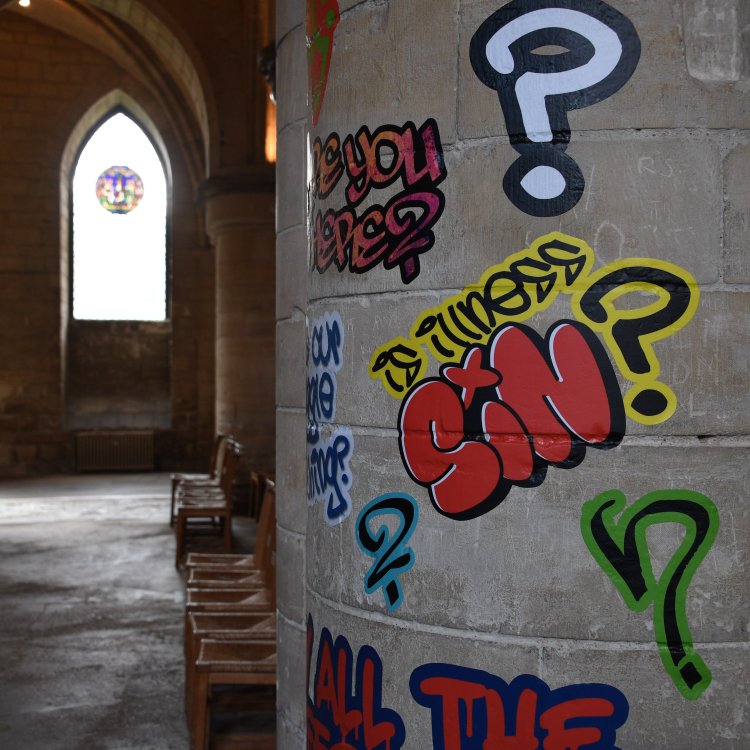Vance, Musk Rebuke Graffiti Exhibition in UK’s Canterbury Cathedral

Vance, Musk Rebuke Graffiti Exhibition in UK’s Canterbury Cathedral
Graffiti on sacred walls sparks global backlash as Church of England defends inclusive art installation
Canterbury, UK – Oct. 13, 2025
A bold new art installation inside the historic Canterbury Cathedral has ignited international outrage, drawing criticism from religious leaders, public figures, and commentators across the political spectrum.
The exhibit, titled “Hear Us,” is set to open to the public on October 17 and run through January 2026. Curated by artist Jacquiline Creswell and poet Alex Vellis, the installation invites visitors to engage with raw, graffiti-style questions scrawled across the ancient cathedral’s stone walls some dating back more than 1,400 years.
Among the questions displayed:
-
“Are you there?”
-
“Why did you create hate when love is by far more powerful?”
-
“Do you ever regret your creation?”
According to the cathedral’s website, the installation was developed in collaboration with “marginalised communities” and aims to give voice to spiritual doubts, traumas, and hopes that often go unspoken within traditional religious settings.
Church Defends the Exhibit as Dialogue
Dean David Monteith, the openly gay chief cleric at Canterbury Cathedral, has defended the exhibit as “an act of bridge-building.”
“This art helps us hear the unheard and opens space for conversations we often avoid,” Monteith said in a statement. “It builds bridges between cultures and invites us to reflect honestly.”
However, many see it as a desecration of a sacred space.
International Backlash: “Vandalism in the Name of Art”
U.S. Vice President JD Vance, a practicing Catholic, condemned the project in a widely shared post on X (formerly Twitter):
“It is weird to me that these people don’t see the irony of honoring ‘marginalized communities’ by making a beautiful historical building really ugly.”
Tesla and SpaceX CEO Elon Musk, who has previously described himself as a “cultural Christian,” responded in agreement:
“Absolutely.”
Former royal chaplain and Catholic convert Rev. Gavin Ashenden was even more scathing:
“You ‘build bridges’ by vandalizing superior accomplishments, then flattering the vandals by calling their work ‘raw,’ ‘disruptive,’ and ‘authentic.’”
Religious Groups Call for Immediate Removal
A UK protest group, Disciples of Christ, called the installation “sacrilegious” and demanded its immediate removal:
“Canterbury Cathedral has vandalised itself in the name of art. The Church of England needs reform.”
Many critics have drawn a connection between the exhibit and the leadership of Sarah Mullally, the Church of England’s incoming first female Archbishop of Canterbury, set to be officially recognized shortly after the exhibit ends.
Mullally’s liberal stance on abortion, immigration, and LGBTQ+ issues has led to theological rifts within the global Anglican Communion. The Anglican Church of Nigeria has already cut ties with the Church of England in response to her appointment.
Wider Implications: The Culture Divide in the Church
Critics say the exhibit is emblematic of the Church of England’s ongoing shift from historic orthodoxy to progressive cultural alignment. Both Dean Monteith and poet Alex Vellis, the artist behind the project, represent identities and worldviews that challenge traditional Anglican values Monteith being openly gay, and Vellis identifying as nonbinary.
Rev. Ben Johnson, an Orthodox priest in the UK, responded on X with a sharp contrast:
“Canterbury Cathedral, founded by a 6th-century saint & now occupied by Sarah Mullally, covered its walls in graffiti for a woke art project. The Orthodox Church’s proper iconography has never been more important.”
Similarly, Rev. Dwight Longenecker, a former Anglican who converted to Catholicism, noted:
“The appointment of a feminist, pro-choice Archbishop and a partnered gay Dean makes the Church’s new direction formal and explicit.”
A Church at a Crossroads
Whether viewed as courageous or catastrophic, the “Hear Us” exhibit reflects the ongoing identity struggle within the Church of England. As it tries to reach a new generation and connect with those traditionally left out, it risks alienating those still rooted in its ancient traditions.
As the voices grow louder on both sides, one thing is certain: the Church is no longer just a place of quiet reflection but a battleground for what it means to be sacred in the 21st century.
Further Readings:























